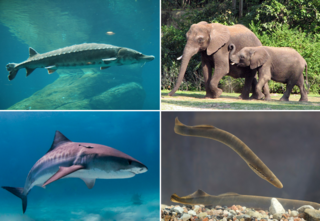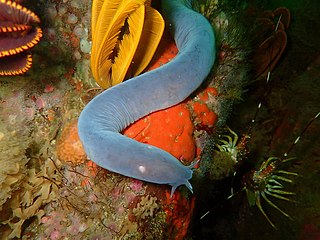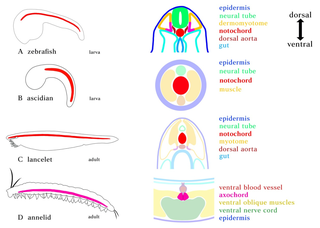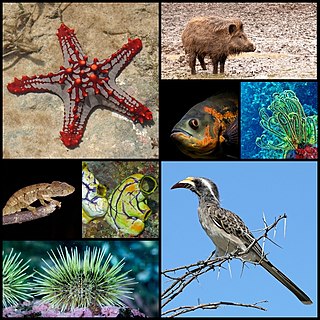
A chordate is a deuterostomic animal belonging to the phylum Chordata. All chordates possess, at some point during their larval or adult stages, five distinctive physical characteristics (synapomorphies) that distinguish them from other taxa. These five synapomorphies are a notochord, a hollow dorsal nerve cord, an endostyle or thyroid, pharyngeal slits, and a post-anal tail. The name "chordate" comes from the first of these synapomorphies, the notochord, which plays a significant role in chordate body plan structuring and movements. Chordates are also bilaterally symmetric, have a coelom, possess a closed circulatory system, and exhibit metameric segmentation.

Vertebrates are deuterostomal animals with bony or cartilaginous axial endoskeleton — known as the vertebral column, spine or backbone — around and along the spinal cord, including all fish, amphibians, reptiles, birds and mammals. The vertebrates consist of all the taxa within the subphylum Vertebrata and represent the overwhelming majority of the phylum Chordata, with currently about 69,963 species described.

Hagfish, of the class Myxini and order Myxiniformes, are eel-shaped jawless fish. Hagfish are the only known living animals that have a skull but no vertebral column, although they do have rudimentary vertebrae. Hagfish are marine predators and scavengers who can defend themselves against other larger predators by releasing copious amounts of slime from mucous glands in their skin.

Agnatha is an infraphylum of jawless fish in the phylum Chordata, subphylum Vertebrata, consisting of both living (cyclostomes) and extinct species. Among recent animals, cyclostomes are sister to all vertebrates with jaws, known as gnathostomes.

A craniate is a member of the Craniata, a proposed clade of chordate animals with a skull of hard bone or cartilage. Living representatives are the Myxini (hagfishes), Hyperoartia, and the much more numerous Gnathostomata. Formerly distinct from vertebrates by excluding hagfish, molecular and anatomical research in the 21st century has led to the reinclusion of hagfish as vertebrates, making living craniates synonymous with living vertebrates.

A tunicate is a marine invertebrate animal, a member of the subphylum Tunicata. It is part of the Chordata, a phylum which includes all animals with dorsal nerve cords and notochords. The subphylum was at one time called Urochordata, and the term urochordates is still sometimes used for these animals. They are the only chordates that have lost their myomeric segmentation, with the possible exception of the 'seriation of the gill slits'. However, doliolids still display segmentation of the muscle bands.

In zoology and developmental anatomy, the notochord is an elastic, rod-like anatomical structure found in many deuterostomal animals. A notochord is one of five synapomorphies used to define a species as a chordate.

Pikaia gracilens is an extinct, primitive chordate animal known from the Middle Cambrian Burgess Shale of British Columbia. Described in 1911 by Charles Doolittle Walcott as an annelid, and in 1979 by Harry B. Whittington and Simon Conway Morris as a chordate, it became "the most famous early chordate fossil", or "famously known as the earliest described Cambrian chordate". It is estimated to have lived during the latter period of the Cambrian explosion. Since its initial discovery, more than a hundred specimens have been recovered.

Ascidiacea, commonly known as the ascidians or sea squirts, is a paraphyletic class in the subphylum Tunicata of sac-like marine invertebrate filter feeders. Ascidians are characterized by a tough outer "tunic" made of a polysaccharide.

The lancelets, also known as amphioxi, consist of some 30 to 35 species of "fish-like" benthic filter feeding chordates in the subphylum Cephalochordata, class Leptocardii, and family Branchiostomatidae.

Cephalization is an evolutionary trend in animals that, over many generations, the special sense organs and nerve ganglia become concentrated towards the rostral end of the body where the mouth is located, often producing an enlarged head. This is associated with the animal's movement direction and bilateral symmetry, and cephalization of the nervous system led to the formation of a functional centralized brain in three groups of bilaterian animals, namely the arthropods, cephalopod molluscs, and vertebrates (craniates).

Neural crest cells are a temporary group of cells that arise from the embryonic ectoderm germ layer, and in turn give rise to a diverse cell lineage—including melanocytes, craniofacial cartilage and bone, smooth muscle, peripheral and enteric neurons and glia.

Ciona intestinalis is an ascidian, a tunicate with very soft tunic. Its Latin name literally means "pillar of intestines", referring to the fact that its body is a soft, translucent column-like structure, resembling a mass of intestines sprouting from a rock. It is a globally distributed cosmopolitan species. Since Linnaeus described the species, Ciona intestinalis has been used as a model invertebrate chordate in developmental biology and genomics. Studies conducted between 2005 and 2010 have shown that there are at least two, possibly four, sister species. More recently it has been shown that one of these species has already been described as Ciona robusta. By anthropogenic means, the species has invaded various parts of the world and is known as an invasive species.

Cathaymyrus is a genus of Early Cambrian chordate known from the Chengjiang biota in Yunnan Province, China. Both species have a long segmented body with no distinctive head. The segments resemble the v-shaped muscle blocks found in cephalochordates such as Amphioxus. A long linear impression runs along the "back" of the body looking something like a chordate notochord.
The 2R hypothesis or Ohno's hypothesis, first proposed by Susumu Ohno in 1970, is a hypothesis that the genomes of the early vertebrate lineage underwent two complete genome duplications, and thus modern vertebrate genomes reflect paleopolyploidy. The name derives from the 2 rounds of duplication originally hypothesized by Ohno, but refined in a 1994 version, and the term 2R hypothesis was probably coined in 1999. Variations in the number and timings of genome duplications typically still are referred to as examples of the 2R hypothesis.

Botrylloides violaceus is a colonial ascidian. It is commonly known as the chain tunicate, but has also been called several other common names, including: lined colonial tunicate, orange sheath tunicate, orange tunicate, and violet tunicate. Its native range is in the northwest Pacific from southern China to Japan and Siberia. Colonies grow on solid substrates and consist of individuals arranged in twisting rows. Outside its native range, it is considered an invasive species and is becoming more common in coastal waters of North America and other waters around the world, likely being spread by shipping industries.

Metaspriggina is a genus of chordate initially known from two specimens in the Middle Cambrian Burgess Shale and 44 specimens found in 2012 at the Marble Canyon bed in Kootenay National Park.

Deuterostomes are bilaterian animals of the superphylum Deuterostomia, typically characterized by their anus forming before the mouth during embryonic development. Deuterostomia is further divided into 4 phyla: Chordata, Echinodermata, Hemichordata, and the extinct Vetulicolia known from Cambrian fossils. The extinct clade Cambroernida is also thought to be a member of Deuterostomia.
Branchiostoma floridae, the Florida lancelet, is a lancelet of the genus Branchiostoma. The genome of this species has been sequenced, revealing that among the chordates, the morphologically simpler tunicates are actually more closely related to vertebrates than lancelets. An embryo of a Florida amphioxus has a larval pharynx with gill slits that is asymmetrical. The gill slits in the larval pharynx form in the center of the embryo when it is in its earliest stage of development (primordial) meaning the thick layer of endoderm is overlapped by a thin layer; which aids into making the B. floridae asymmetrical from left to right. The lancelet Branchiostoma floridae maintains a high level of Fox transcription factor gene diversity, with 32 distinct Fox genes in its genome, and 21,229 clusters of cDNA clones, making it very useful to the research community.
Linda Zimmerman Holland is a research biologist at Scripps Institution of Oceanography known for her work examining the evolution of vertebrates.
















